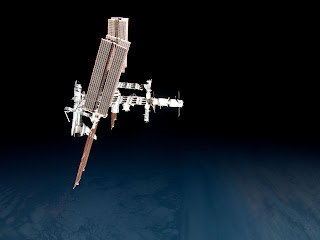With Harv Hartman in front of the Apollo 17 Command Module. Harv retired as Director of HR at JSC. He joined NASA towards the end of the Gemini program and stayed on until the construction of the International Space Station. He had lots of great stories to tell.
Part 3: You would think it couldn't possibly get any better, but it did! Just to recap the day. We spent the night at The Houstonion Hotel. Had breakfast with Astronaut Terry Wilcutt. Then on the way to JSC we watched episode 5 of From the Earth to the Moon. This episode was about Tom Kelly and the team at Grumman designing and developing the Lunar Module. Our first stop was the Rocket Park where we saw a Saturn V (this one was slated to fly to the Moon as Apollo 18 before the mission was cancelled). Then we walked over to the Astronaut Memorial Grove. Then listened to an awesome lunch presentation on the Alpha Magnetic Spectrometer. We spent the afternoon at the Neutral Buoyancy Laboratory. Quite a full day so far, but there was more to come. Jeff Jackson, Dick Richardson, Matt Gray, Terry Willcutt and Harv Hartman had more in store for us. I was in orbit already!
Next, we drove to Space Center Houston (SCH) where we had a classroom session and recapped the key learning's of the day. After that we had some free time to wonder around the SCH. Harv had pointed me to the Space Shuttle Simulator and I decided to give it a shot. On my first try I ended up doing a pretty good landing. Harv was there right next to me and was my witness. Later that evening he announced to the whole class that I had "greased" the landing. I was smiling so hard all evening my jaw was aching the following morning.
We watched a movie of the Apollo 11 moon landing in the Destiny Theater. The discussion there was about the "team" effort needed to get the first men on the Moon. Everyone had a role, played their part and everyone relied on each other. What better example of this than the "1201 alarms" going on during the descent and the back room guys giving Gene Kranz the GO for landing.
Our reception at the Destiny Theater (with wine and appetizers) was followed by an amazing presentation by a scientist who talked about the research being conducted on the ISS. The ISS has been designated a National Laboratory by Congress. It is truly amazing to think that the ISS was launched in 1998 and that we have had a continuous human presence in orbit for over ten years!
We then went on for a private dinner at the Starship Gallery. Yup!
"Faith 7" Mercury Spacecraft flown by Gordon Cooper. This was the last flight of the Mercury program. Cooper flew a total of 22 orbits (May 15-16, 1962).
Apollo 17 was the 6th and last lunar landing and was crewed by Eugene Cernen (Commander), Ronald Evans (Command Module Pilot), and Harrison Schmitt (Lunar Module Pilot).
Apollo 17 Command Module "America"
Apollo EVA Space Suits
Training model of the Lunar Roving Vehicle (AKA "the Moon buggy"). Rovers were used on Apollo 15, 16 and 17.
Moon rocks. Actually touched one.
Interior of Skylab
Among the many fascinating artifacts was this training mock up of the inside of Skylab. This was our first Space Station and was launched in 1973 and deorbited in 1979 after three long duration missions.
I could easily have spent an entire day just in the Starship Gallery
Astronaut on an EVA with the ISS in the background
Training mock up of the Lunar Module (LM)
Robonaut 2 is now aboard the ISS and was launched on STS-133
The main gallery at Space Center Houston has several historical artifacts including space suits.
Prior to the Challenger explosion astronauts wore just flight suits and helmets. After Challenger they switched to the now famous orange pressure suits.
Space Shuttle space suit
Orlan space suit used by the Russians for EVA
We had an amazing day and the best was yet to come - a visit to the historical Apollo Mission Control center and the ISS Mission Control center. That's for Part 4.









